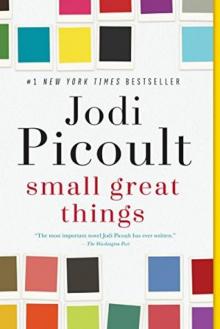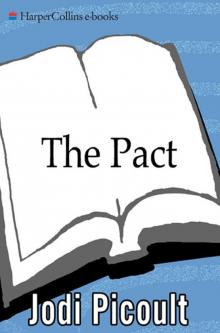- Home
- Jodi Picoult
Leaving Time: A Novel
Leaving Time: A Novel Read online
This is a work of fiction. Names, characters, places, and incidents are the products of the author’s imagination or are used fictitiously. Any resemblance to actual events, locales, or persons, living or dead, is entirely coincidental.
Copyright © 2014 by Jodi Picoult
All rights reserved.
Published in the United States by Ballantine Books, an imprint of Random House, a division of Random House LLC, a Penguin Random House Company, New York.
BALLANTINE and the HOUSE colophon are registered trademarks of Random House LLC.
Grateful acknowledgment is given for permission to reprint “The Elephant” from NATURAL HISTORY by Dan Chiasson, copyright © 2005 by Dan Chiasson. Used by permission of Alfred A. Knopf, an imprint of the Knopf Doubleday Publishing Group, a division of Random House LLC. All rights reserved.
Library of Congress Cataloging-in-Publication Data
Picoult, Jodi.
Leaving time : a novel / Jodi Picoult
pages cm
ISBN: 978-0-345-54492-6
eBook ISBN: 978-0-345-54493-3
1. Teenage girls—Fiction. 2. Mothers and daughters—Fiction.
3. Missing persons—Fiction I. Title.
PS3566.I372 L43 2014
813’.54—dc23 2014023994
www.ballantinebooks.com
Jacket design: Gabrielle Bordwin
Jacket photograph: © David Jordan Williams
v3.1
Contents
Cover
Title Page
Copyright
Prologue
Jenna
Alice
Part I
Chapter 1: Jenna
Chapter 2: Alice
Chapter 3: Serenity
Chapter 4: Alice
Chapter 5: Jenna
Chapter 6: Alice
Chapter 7: Virgil
Chapter 8: Alice
Chapter 9: Jenna
Chapter 10: Alice
Chapter 11: Serenity
Chapter 12: Alice
Chapter 13: Jenna
Chapter 14: Alice
Chapter 15: Serenity
Chapter 16: Alice
Chapter 17: Jenna
Part II
Chapter 18: Alice
Chapter 19: Virgil
Chapter 20: Alice
Chapter 21: Jenna
Chapter 22: Alice
Chapter 23: Serenity
Chapter 24: Alice
Chapter 25: Virgil
Chapter 26: Alice
Chapter 27: Jenna
Chapter 28: Alice
Chapter 29: Serenity
Chapter 30: Alice
Chapter 31: Jenna
Chapter 32: Alice
Chapter 33: Virgil
Chapter 34: Alice
Chapter 35: Serenity
Chapter 36: Alice
Chapter 37: Jenna
Chapter 38: Alice
Chapter 39: Virgil
Chapter 40: Alice
Chapter 41: Serenity
Chapter 42: Alice
Chapter 43: Jenna
Author’s Note
Dedication
Acknowledgments
Other Books by This Author
About the Author
PROLOGUE
JENNA
Some people used to believe that there was an elephant graveyard—a place that sick and old elephants would travel to to die. They’d slip away from their herds and would lumber across the dusty landscape, like the titans we read about in seventh grade in Greek Mythology. Legend said the spot was in Saudi Arabia; that it was the source of a supernatural force; that it contained a book of spells to bring about world peace.
Explorers who went in search of the graveyard would follow dying elephants for weeks, only to realize they’d been led in circles. Some of these voyagers disappeared completely. Some could not remember what they had seen, and not a single explorer who claimed to have found the graveyard could ever locate it again.
Here’s why: The elephant graveyard is a myth.
True, researchers have found groups of elephants that died in the same vicinity, many over a short period of time. My mother, Alice, would have said there’s a perfectly logical reason for a mass burial site: a group of elephants who died all at once due to lack of food or water; a slaughter by ivory hunters. It’s even possible that the strong winds in Africa could blow a scattering of bones into a concentrated pile. Jenna, she would have told me, there’s an explanation for everything you see.
There is plenty of information about elephants and death that is not fable but instead cold, hard science. My mother would have been able to tell me that, too. We would have sat, shoulder to shoulder, beneath the massive oak where Maura liked to shade herself, watching the elephant pick up acorns with her trunk and pitch them. My mother would rate each toss like an Olympic judge. 8.5 … 7.9. Ooh! A perfect 10.
Maybe I would have listened. But maybe, too, I would have just closed my eyes. Maybe I would have tried to memorize the smell of bug spray on my mother’s skin, or the way she absentmindedly braided my hair, tying it off on the end with a stalk of green grass.
Maybe the whole time I would have been wishing there really was an elephant graveyard, except not just for elephants. Because then I’d be able to find her.
ALICE
When I was nine—before I grew up and became a scientist—I thought I knew everything, or at least I wanted to know everything, and in my mind there was no difference between the two. At that age, I was obsessed with animals. I knew that a group of tigers was called a streak. I knew that dolphins were carnivores. I knew that giraffes had four stomachs and that the leg muscles of a locust were a thousand times more powerful than the same weight of human muscle. I knew that white polar bears had black skin beneath their fur, and that jellyfish had no brains. I knew all these facts from the Time-Life monthly animal fact cards that I had received as a birthday gift from my pseudo-stepfather, who had moved out a year ago and now lived in San Francisco with his best friend, Frank, who my mother called “the other woman” when she thought I wasn’t listening.
Every month new cards arrived in the mail, and then one day, in October 1977, the best card of all arrived: the one about elephants. I cannot tell you why they were my favorite animals. Maybe it was my bedroom, with its green shag jungle carpet and the wallpaper border of cartoon pachyderms dancing across the walls. Maybe it was the fact that the first movie I’d ever seen, as a toddler, was Dumbo. Maybe it was because the silk lining inside my mother’s fur coat, the one she had inherited from her own mother, was made from an Indian sari and printed with elephants.
From that Time-Life card, I learned the basics about elephants. They were the largest land animals on the planet, sometimes weighing more than six tons. They ate three to four hundred pounds of food each day. They had the longest pregnancy of any land mammal—twenty-two months. They lived in breeding herds, led by a female matriarch, often the oldest member of the group. She was the one who decided where the group went every day, when they took a rest, where they ate, and where they drank. Babies were raised and protected by all the female relatives in the herd, and traveled with them, but when males were about thirteen years old, they left—sometimes preferring to wander on their own and sometimes gathering with other males in a bull group.
But those were facts that everyone knew. I, on the other hand, became obsessed and dug a little deeper, trying to find out everything I could at the school library and from my teachers and books. So I also could tell you that elephants got sunburned, which is why they would toss dirt on their backs and roll in the mud. Their closest living relative was the rock hyrax, a tiny, furry thing that looked like a guinea pig. I knew that ju
st like a human baby sucks its thumb to calm itself down, an elephant calf might sometimes suck its trunk. I knew that in 1916, in Erwin, Tennessee, an elephant named Mary was tried and hanged for murder.
In retrospect I am sure my mother got tired of hearing about elephants. Maybe that is why, one Saturday morning, she woke me before the sun came up and told me we were going on an adventure. There were no zoos near where we lived in Connecticut, but the Forest Park Zoo in Springfield, Massachusetts, had a real, live elephant—and we were going to see her.
To say I was excited would be an understatement. I peppered my mother with elephant jokes for hours:
What’s beautiful, gray, and wears glass slippers? Cinderelephant.
Why are elephants wrinkled? They don’t fit on the ironing board.
How do you get down from an elephant? You don’t. You get down from a goose.
Why do elephants have trunks? Because they’d look funny with glove compartments.
When we got to the zoo, I raced along the paths until I found myself standing in front of Morganetta the elephant.
Who looked nothing like what I had imagined.
This was not the majestic animal featured on my Time-Life card, or in the books I had studied. For one thing, she was chained to a giant concrete block in the center of her enclosure, so that she couldn’t walk very far in any direction. There were sores on her hind legs from the shackles. She was missing one eye, and she wouldn’t look at me with the other. I was just another person who had come to stare at her, in her prison.
My mother was stunned by her condition, too. She flagged down a zookeeper, who said that Morganetta had once been in local parades, and had done stunts like competing against undergrads in a tug-o’-war at a nearby school, but that she had gotten unpredictable and violent in her old age. She’d lashed out at visitors with her trunk if they came too close to her cage. She had broken a caregiver’s wrist.
I started to cry.
My mother bundled me back to the car for the four-hour drive home, although we had only been at the zoo for ten minutes.
“Can’t we help her?” I asked.
This is how, at age nine, I became an elephant advocate. After a trip to the library, I sat down at my kitchen table, and I wrote to the mayor of Springfield, Massachusetts, asking him to give Morganetta more space, and more freedom.
He didn’t just write me back. He sent his response to The Boston Globe, which published it, and then a reporter called to do a story on the nine-year-old who had convinced the mayor to move Morganetta into the much larger buffalo enclosure at the zoo. I was given a special Concerned Citizen award at my elementary school assembly. I was invited back to the zoo for the grand opening to cut the red ribbon with the mayor. Flashbulbs went off in my face, blinding me, as Morganetta roamed behind us. This time, she looked at me with her good eye. And I knew, I just knew, she was still miserable. The things that had happened to her—the chains and the shackles, the cage and the beatings, maybe even the memory of the moment she was taken out of Africa—all that was still with her in that buffalo enclosure, and it took up all the extra space.
For the record, Mayor Dimauro did continue to try to make life better for Morganetta. In 1979, after the demise of Forest Park’s resident polar bear, the facility closed and Morganetta was moved to the Los Angeles Zoo. Her home there was much bigger. It had a pool, and toys, and two older elephants.
If I knew back then what I know now, I could have told the mayor that just sticking elephants in proximity with others does not mean they will form friendships. Elephants are as unique in their personalities as humans are, and just as you would not assume that two random humans would become close friends, you should not assume that two elephants will bond simply because they are both elephants. Morganetta continued to spiral deeper into depression, losing weight and deteriorating. Approximately one year after she arrived in L.A., she was found dead in the bottom of the enclosure’s pool.
The moral of this story is that sometimes, you can attempt to make all the difference in the world, and it still is like trying to stem the tide with a sieve.
The moral of this story is that no matter how much we try, no matter how much we want it … some stories just don’t have a happy ending.
PART I
How to explain my heroic courtesy? I feel
that my body was inflated by a mischievous boy.
Once I was the size of a falcon, the size of a lion,
once I was not the elephant I find I am.
My pelt sags, and my master scolds me for a botched
trick. I practiced it all night in my tent, so I was
somewhat sleepy. People connect me with sadness
and, often, rationality. Randall Jarrell compared me
to Wallace Stevens, the American poet. I can see it
in the lumbering tercets, but in my mind
I am more like Eliot, a man of Europe, a man
of cultivation. Anyone so ceremonious suffers
breakdowns. I do not like the spectacular experiments
with balance, the high-wire act and cones.
We elephants are images of humility, as when we
undertake our melancholy migrations to die.
Did you know, though, that elephants were taught
to write the Greek alphabet with their hooves?
Worn out by suffering, we lie on our great backs,
tossing grass up to heaven—as a distraction, not a prayer.
That’s not humility you see on our long final journeys:
it’s procrastination. It hurts my heavy body to lie down.
—DAN CHIASSON, “The Elephant”
JENNA
When it comes to memory, I’m kind of a pro. I may only be thirteen, but I’ve studied it the way other kids my age devour fashion magazines. There’s the kind of memory you have about the world, like knowing that stoves are hot and that if you don’t wear shoes outside in the winter you’ll get frostbite. There’s the kind you get from your senses—that staring at the sun makes you squint and that worms aren’t the best choice of meal. There are the dates you can recall from history class and spew back on your final exam, because they matter (or so I’m told) in the grand scheme of the universe. And there are personal details you remember, like the high spikes on a graph of your own life, which matter to nobody but yourself. Last year at school, my science teacher let me do a whole independent study on memory. Most of my teachers let me do independent studies, because they know I get bored in class and, frankly, I think they’re a little scared that I know more than they do and they don’t want to have to admit it.
My first memory is white at the edges, like a photo taken with too bright a flash. My mother is holding spun sugar on a cone, cotton candy. She raises her finger to her lips—This is our secret—and then tears off a tiny piece. When she touches it to my lips, the sugar dissolves. My tongue curls around her finger and sucks hard. Iswidi, she tells me. Sweet. This is not my bottle; it’s not a taste I know, but it’s a good one. Then she leans down and kisses my forehead. Uswidi, she says. Sweetheart.
I can’t be more than nine months old.
This is pretty amazing, really, because most kids trace their first memories to somewhere between the ages of two and five. That doesn’t mean that babies are little amnesiacs—they have memories long before they have language but, weirdly, can’t access them once they start talking. Maybe the reason I remember the cotton candy episode is because my mother was speaking Xhosa, which isn’t our language but one she picked up when she was working on her doctorate in South Africa. Or maybe the reason I have this random memory is as a trade-off my brain made—because I can’t remember what I desperately wish I could: details of the night my mother disappeared.
My mother was a scientist, and for a span of time, she even studied memory. It was part of her work on post-traumatic stress and elephants. You know the old adage that elephants never forget? Well, it’s fact. I could give you all my mother’s dat
a, if you want the proof. I’ve practically got it memorized, no pun intended. Her official published findings were that memory is linked to strong emotion, and that negative moments are like scribbling with permanent marker on the wall of the brain. But there’s a fine line between a negative moment and a traumatic one. Negative moments get remembered. Traumatic ones get forgotten, or so warped that they are unrecognizable, or else they turn into the big, bleak, white nothing I get in my head when I try to focus on that night.
Here’s what I know:
1. I was three.
2. My mother was found on the sanctuary property, unconscious, about a mile south of a dead body. This was in the police reports. She was taken to the hospital.
3. I am not mentioned in the police reports. Afterward, my grandmother took me to stay at her place, because my father was frantically dealing with a dead elephant caregiver and a wife who had been knocked out cold.
4. Sometime before dawn, my mother regained consciousness and vanished from the hospital without any staff seeing her go.
5. I never saw her again.
Sometimes I think of my life as two train cars hitched together at the moment of my mom’s disappearance—but when I try to see how they connect there’s a jarring on the track that jerks my head back around. I know that I used to be a girl whose hair was strawberry blond, who ran around like a wild thing while my mother took endless notes about the elephants. Now I’m a kid who is too serious for her age and too smart for her own good. And yet as impressive as I am with scientific statistics, I fail miserably when it comes to real-life facts, like knowing that Wanelo is a website and not a hot new band. If eighth grade is a microcosm of the social hierarchy of the human adolescent (and to my mother, it certainly would have been), then reciting fifty named elephant herds in the Tuli Block of Botswana cannot compete with identifying all the members of One Direction.

 Small Great Things
Small Great Things Leaving Time
Leaving Time Nineteen Minutes
Nineteen Minutes Larger Than Life
Larger Than Life Perfect Match
Perfect Match My Sister's Keeper
My Sister's Keeper The Pact
The Pact Handle With Care
Handle With Care Songs of the Humpback Whale
Songs of the Humpback Whale Mermaid
Mermaid The Tenth Circle
The Tenth Circle The Color War
The Color War Leaving Home: Short Pieces
Leaving Home: Short Pieces House Rules
House Rules Lone Wolf
Lone Wolf The Storyteller
The Storyteller The Book of Two Ways
The Book of Two Ways Shine
Shine Off the Page
Off the Page Sing You Home
Sing You Home Second Glance: A Novel
Second Glance: A Novel Mercy
Mercy Vanishing Acts
Vanishing Acts Between the Lines
Between the Lines Plain Truth
Plain Truth Salem Falls
Salem Falls Keeping Faith
Keeping Faith Harvesting the Heart
Harvesting the Heart Change of Heart
Change of Heart Where There's Smoke
Where There's Smoke Leaving Time: A Novel
Leaving Time: A Novel Over the Moon
Over the Moon House Rules: A Novel
House Rules: A Novel The Jodi Picoult Collection #2
The Jodi Picoult Collection #2 Leaving Home: Short Pieces (Kindle Single)
Leaving Home: Short Pieces (Kindle Single) My Sister's Keeper: A Novel
My Sister's Keeper: A Novel![Mermaid [Kindle in Motion] (Kindle Single) Read online](http://i1.bookreadfree.com/i1/04/03/mermaid_kindle_in_motion_kindle_single_preview.jpg) Mermaid [Kindle in Motion] (Kindle Single)
Mermaid [Kindle in Motion] (Kindle Single) The Jodi Picoult Collection #4
The Jodi Picoult Collection #4 Sing You Home: A Novel
Sing You Home: A Novel The Jodi Picoult Collection
The Jodi Picoult Collection Lone Wolf A Novel
Lone Wolf A Novel Second Glance
Second Glance Larger Than Life (Novella)
Larger Than Life (Novella) The Jodi Picoult Collection #3
The Jodi Picoult Collection #3